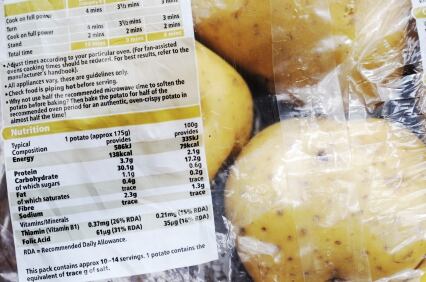In a new study, the FSA (Food Standards Agency) claim food labels are often ignored when buying ‘the usual’ groceries in the weekly shopping list.
Most Northern Irish consumers described their shopping behaviour as routine and repetitive. They tended to use labels just for identifying specific ingredients because of dietary of allergy requirements or occasionally to scrutinise a new product.
However, the new findings suggest more uniformity between labels and better visualisation – for example bigger font sizes for the many shoppers struggling to read the information – could help consumers make better decisions at a glance.
“In-store shoppers often only allow seconds to consult a food label before purchasing and participants relayed that any information given should facilitate a snap decision in the food aisle,” the researchers said.
“As such, there is potential to increase usage of labelling information if it is presented in a more visual format, requiring minimum cognitive effort. (…) Participants recommended using large and bold fonts to highlight key facts.”
Less numerical data was one way to facilitate better and faster decision-making, as was ensuring label information is in plain English for quick and easy information without confusion.
The study

The new research involved 64 participants – both supermarket and online shoppers – in eight focus group discussions. Each group contained a mix of socioeconomic backgrounds, with consumers hailing from four Northern Ireland locations; Belfast, Londonderry, Glengormley and Portrush.
Participants were presented with a range of food packaging and asked to prioritise information.
Some were observed doing a ‘normal shop’ and a follow-up interview was carried out to help understand purchasing decisions.
“’Use by/best before’ and ‘nutrition information’ were overall the most highly consulted information on food labels. However, there was still confusion over how to interpret this information to enable smarter choices in the food aisle,” the team, led by TNS BMRB Research, said.
Study participants thought label information was too inconsistent or numerical to inform their choices. They were often confused around when information should be used, and if it is guidance or strict instruction, the researchers added.
“Participants sought out short-cuts for healthiness and quality or relied on their own instincts when confusion arose. This drove a tendency to ignore information presented,” they said.
Yet, despite these barriers, consumers wanted more understandable label information, particularly regarding nutrition and portion size, which the researchers believed was due to social trends towards healthy eating.
Online shoppers
Those who shopped online were less likely to consider food labelling because they prioritised speed and convenience.
“Online shoppers had low awareness that labelling information was available to them, and there is potential to raise knowledge levels to encourage usage in this area,” the researchers added.
“Although as previous research has shown participants may be unlikely to click through or scroll down a webpage to view this information there may be a need to consider providing this without shoppers having to seek it out, for example via hover-over on a main product description page.”
Food labels under fire

The study is not the first to put UK food labelling under scrutiny, with headlines in recent years branding it “confusing” and blaming it as a contributing factor to unhealthy eating.
The new findings compliment another recent study which suggested detailed-nutritional fact panels are less likely to influence non-health conscious shoppers than health-focussed people.
However, attempts at more visual dietary guidance have not always been met with open arms – for instance, the UK ‘Eatwell’ plate. Its usefulness has been the subject of debate.
“There seems to be constant criticism of guidelines on nutrition at the moment but the bottom line is that guidelines are meaningless if they are not put into practice. As a nation we know that we still have a way to go before we achieve this,” Victoria Taylor, senior dietitian at the British Heart Foundation, said.
